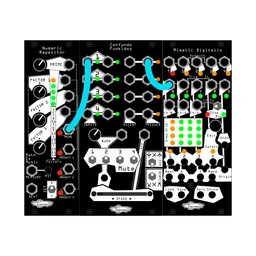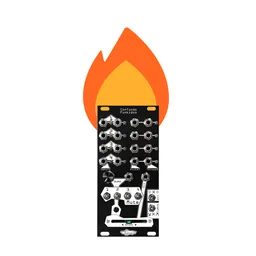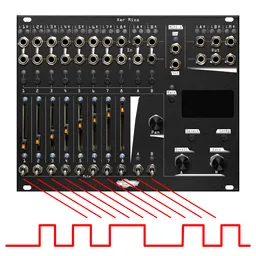This is part of a series of tutorials based on user questions that we seem to get a lot. Are you new to modular and have a question about Eurorack? Are you an advanced user and have burning technical questions? Please submit ideas for this occasional column here.
I love CVs. Who doesn't? But I also frequently run up against space constraints in my case, as I bet many of you do too. My compromise for this has been to use gate/trigger sources as CVs. I'm absolutely not the only one who has thought of this, but I've seen enough people surprised by this when I give demos that I think it warrants some discussion. And of course a badass demonstration or two of how you can use it in your own case.
What is a CV and how does it work?
Let's start with a brief overview of CVs. As the name suggests, a voltage sent from one module to a CV-input can control a parameter on another module, like pitch, mode, etc. CV sources typically send voltages across a wide range, and generally continually output a voltage of some value. When you send a continuous CV in, it will continuously modify your parameter. For example, here I patched the Mannequins Just Friends by Whimsical Raps in as a CV source to the Morph input on our Basimilus Iteritas Alter.
In green, we see the Just Friends voltage rising and falling. In yellow, the BIA waveform shape is continually changing over the period of the green Just Friends input wave.

Green shows the input control voltage (CV) and yellow shows the output audio waveform being modified by the CV.
So what's the difference with gates/triggers as CV sources?
In our last blog post, I talked about triggers and gates, and demonstrated that in essence, these, too---like just about everything in modular synth---are just voltages that are routed between modules. As a result, these, too, can be used to control parameters in interesting ways. One perk of doing so is that you can control parameters with rhythm modules (or whatever else you have in your rack). And because they are not continuous signals, they change sounds discretely: each time a trigger is received, voltage increases, and the parameter is modified only for the duration of the voltage bump.
Once again, I patched a CV into the Morph CV input jack on the BIA, this time from our Zularic Repetitor, a rhythm generator that outputs gates/triggers. I have the modules set to trigger on different clocks though so that every other time BIA triggers, the sound is modulated. To see this, look at the green line: when it is high, ZR is sending voltage to BIA and the signal is modulated. When the green line is low, no voltage is sent, and this is the plain, simple BIA signal.

Basimilus Iteritas Alter modulated by Zularic Repetitor: when the green line is high, the signal is modulated. When it is low, the signal is not and you hear only what BIA produces.
The beauty of using rhythmic generators for CVs is that they usually have lots of outputs---that means lots of CVs. For example, Zularic Repetitor outputs four gates/triggers. Below, I have used a mult to duplicate the four outputs and patched each of these to a CV input on a single BIA.
As with all things in life, there's a limitation. Because trigger/gate sources output what is essentially stepped voltage, the input your module receives will have only two values: off or on. That means you will get only two different values from each CV input. This is true even if you have a three-way switch (for example, on the Basimilus Iteritas Alter, if I CV the B/A/T switch with a gate/trigger, I will only get two of the three possible values out. Understanding the limitation makes it a little easier to wrap your head around the sound you get (or don't get) out of your module.
One last example: here's Stephen tooling around with Numeric Repetitor and Cursus Iteritas a while back using the same trick.
Stay tuned to the Noise Engineering blog for more tips and tricks for modular users. And if you have questions you'd like to see here, please drop us a line.






